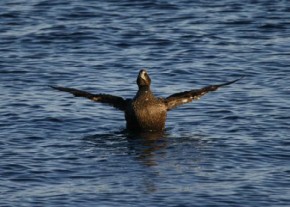Wayne R. Petersen

Wayne R. Petersen
This month readers are confronted with a uniformly dark, swimming waterbird. Assuming this perception is accurate, identification possibilities include some species of duck, a Sooty Shearwater, a cormorant, a juvenile Herring Gull, a dark jaeger, or a Black Guillemot in breeding plumage. A close look can eliminate Sooty Shearwater by the chunky body, relatively short wings compared to the long narrow wings of a shearwater, and the pale colored bill. The relatively short neck and chunky body of the mystery bird removes a cormorant as a possibility, as does the overall brownish rather than black color tone. A juvenile Herring Gull is arguably a good possibility, but a Herring Gull would have longer and more obviously jointed wings and would not have the blocky head shape of the mystery species. A dark jaeger in this posture would have wings that appear more falcon or gull-like than the fairly straight and shorter wings of the pictured bird, and a jaeger’s wings would probably also offer a hint of some contrasting white coloration on its primaries. Additionally, a jaeger’s bill would not be pale like that of the bird in the photograph. A Black Guillemot in breeding plumage would be jet black and would possess white wing linings and a sharp-pointed bill. A duck species is the best remaining alternative.
Females, eclipse males, and juveniles of many species of freshwater ducks, as well as male Harlequin Ducks and female eiders and scoters, all appear uniformly dusky below, so the color uniformity of this duck offers little in the way of an identification clue. The only certainty is that the pictured duck is obviously hefty, with a full chest and a puffy-looking head. A close examination of its pale-colored bill shows that it also seems to extend up well onto the face of the duck. This bill structure and facial feature, combined with the bird’s full-chested appearance, relatively short wings, and uniformly dark underparts all point to the mystery bird’s identity as a female Common Eider (Somateria mollissima). A closer view of the feathers on the underparts indicates that they are horizontally barred in appearance—a feature unique to most species of female eiders. A female King Eider would appear paler underneath and would have a less prominent bill when viewed at the angle shown in the photograph.
Common Eiders are abundant winter visitors in Massachusetts coastal waters, and increasing numbers breed regularly along the Essex County coast, on islands in Boston Harbor, and in Buzzards Bay. Rare on freshwater anywhere in the state, varying numbers of nonbreeding individuals may be found along the coast at virtually any time of year. The author photographed this female eider in Wellfleet Harbor on November 28, 2010.
Wayne R. Petersen